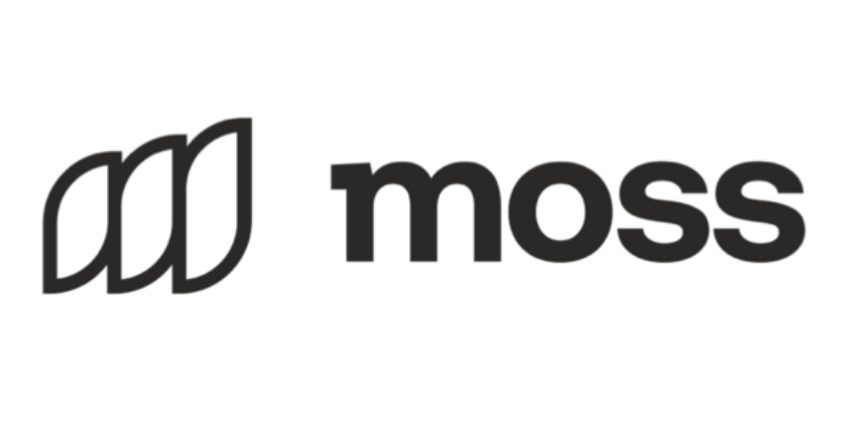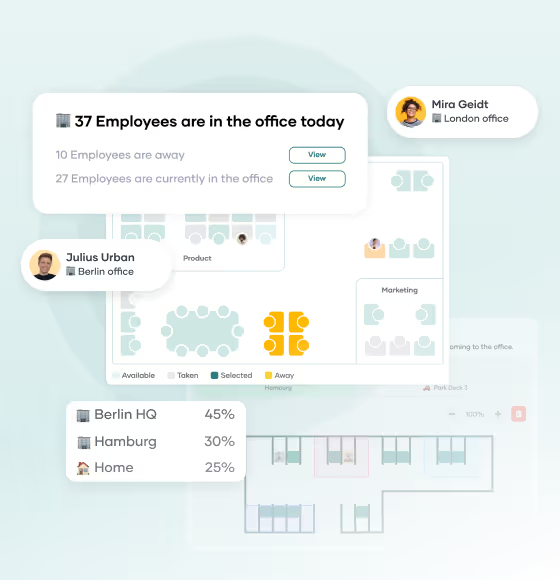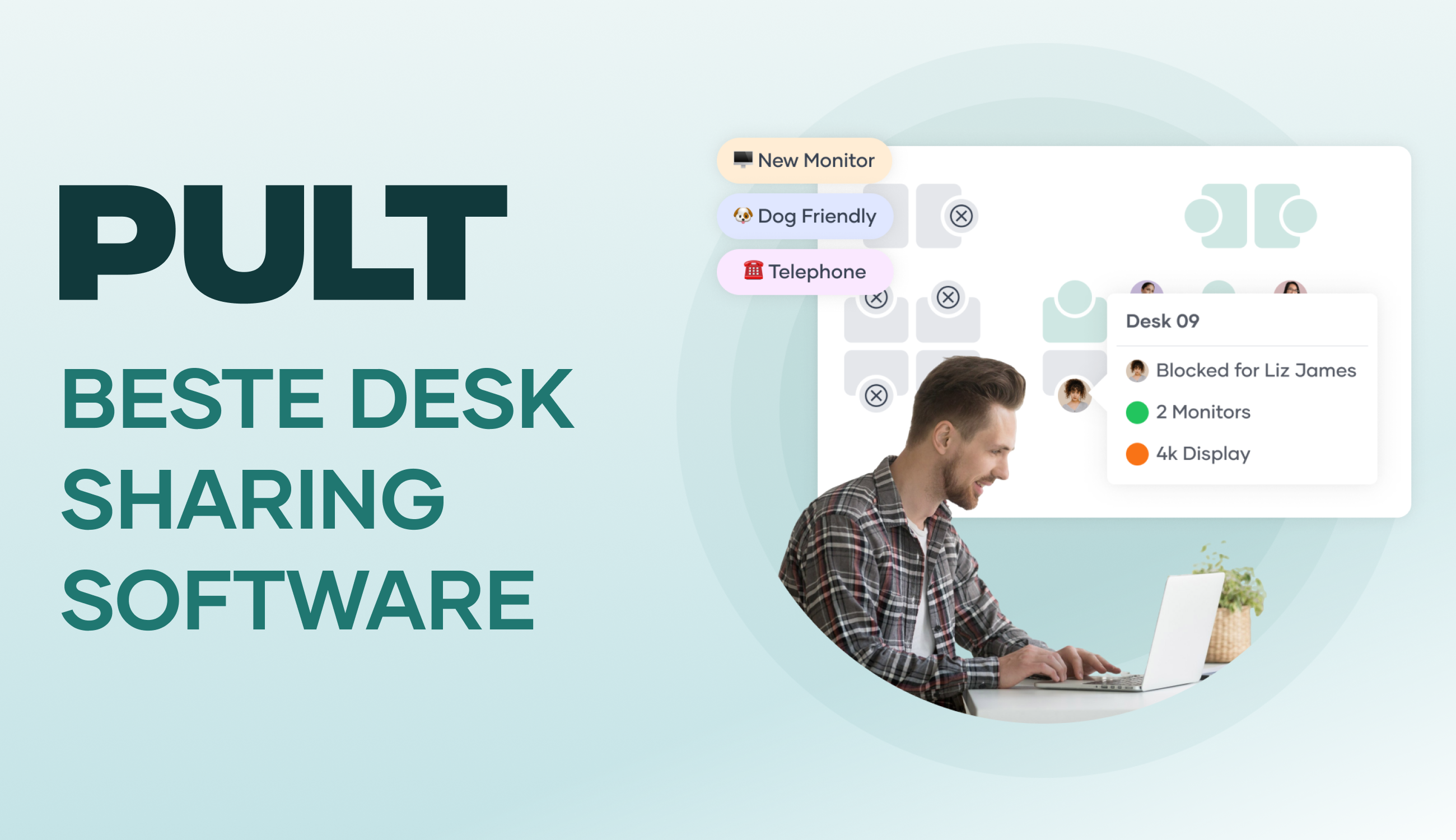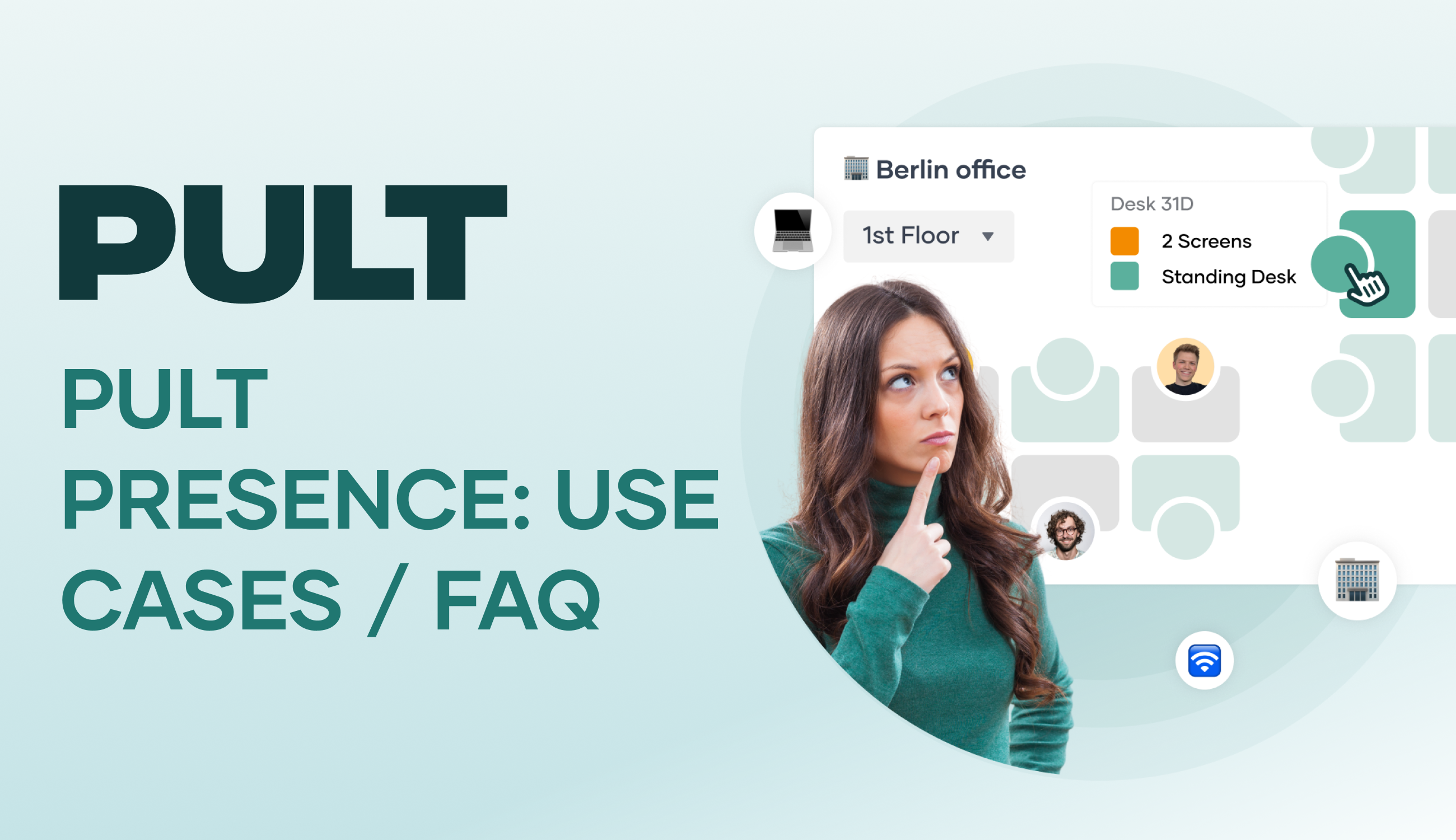Workplace management: basics, tools, and implementation

Workplace management: TL;DR
- Workplace management controls how workstations, rooms, and space are used with the aim of organizing occupancy, costs, and collaboration in an economical way.
- Core tasks: Recording space usage, managing with a booking system, setting rules, and ongoing optimization during operation.
- Key figures: Important KPIs are occupancy rate, utilization rate, no-show rate, desk-sharing rate, and cost per workplace.
- Digital basis: PULT as a workplace management software combines booking, attendance recording, and analysis in one software. Other systems can be connected via API.
What is workplace management?
Workplace management refers to the coordinated control of the use of workspaces, workstations, and associated resources in companies. It ensures that available space reflects the actual needs of the team and is operated economically.
Typical tasks in workplace management are:
- Recording and analysis of space utilization,
- management of booking and occupancy systems,
- adaptation of space structure to organizational changes,
- ensuring workplace and data protection requirements.
Software is used for implementation, for example, desk and room booking software, sometimes in conjunction with sensors for occupancy recording. These systems combine data from space planning, HR, and IT.
How do I set up workplace management?
Workplace management is introduced in four steps: First, record the actual use of your space, establish rules for occupancy and booking, map these processes technically, and then optimize them during ongoing operations.
1. Record the initial situation
Determine how your workspaces are currently being used. Count the available workstations, room types, and space sizes. Document which areas are regularly occupied and where vacancies occur repeatedly.
Use existing sources such as booking systems, access data, or simple inspections. Based on this, create a profile of office attendance with the most important key figures:
- Utilization per zone
- Average occupancy per weekday
- Space requirements per person.
In addition, ask your employees which workstations, rooms, and zones are desired and used on a daily basis.
Tip: With the office evaluation in PULT, you can see exactly how your office is actually being used. You can record actual attendance, bookings, no-shows, and peak days in one system in PULT.
Discover PULT
2. Rules and space concepts
Define how workstations and rooms should be used. Formulate booking rules with lead times, maximum booking duration, and no-show policies.
Assign activities to specific room types: quiet and concentrated work, teamwork, meetings, phone calls.
Take into account the legal minimum standards from the Workplace Ordinance and internal guidelines on data protection and works council participation.
The goal of this step is to create a space concept that reflects how your employees actually work.
3. Choosing the software
To implement this, choose software that covers all aspects of your workplace management:
- Booking individual workstations, rooms, zones, and, if applicable, parking spaces
- Filter options by equipment (e.g., height-adjustable table, two monitors)
- Integration with calendar software such as Microsoft Outlook, Google Calendar, MS Teams
- Definition of booking rights and restrictions (e.g., zones only available to certain teams)
- Automatic release of booked but unused spaces (no-show rule)
- Utilization reports for rooms, workstations, zones, floors, and buildings
Some software requires sensors to be installed for occupancy tracking. This is not the case with the workplace management system PULT: PULT Presence automatically tracks your employees' attendance as soon as their laptop or smartphone connects to the company Wi-Fi.
This way, you always get reliable utilization figures, even if the raw booking data is distorted by no-shows.
The workplace management platform PULT provides numerous functions for comprehensive workplace management: space and room booking, filters and floor plans, booking rules, calendar integration, and much more.
4. Operate and optimize
After implementation, carry out regular evaluations on a monthly or quarterly basis. Compare current occupancy data with target values and identify deviations.
Based on the data, you can continuously adapt the office space to actual needs and provide your employees with the resources they actually require in the best possible way.
The goal is continuous improvement that constantly balances space requirements and operating costs with the demands and needs of employees.
Which key figures are relevant for workplace management?
Digital workplace management works with data from the booking software and draws on attendance figures and utilization values. The key figures show how intensively workspaces are used, where over- or undercapacities arise, and how space utilization compares to costs and demand.
- Occupancy rate: Measures how many workspaces are in use at a given time. Formula: occupied workspaces ÷ available workspaces × 100
- Utilization rate: Shows how much workspaces or rooms are actually used over a period of time. Formula: total usage time ÷ available time × 100
- No-show rate: Percentage of booked but unused workspaces or rooms. Formula: unused bookings ÷ total number of bookings × 100
- Desk sharing ratio: Ratio of employees to available workspaces. Formula: number of employees ÷ number of workspaces
- Space costs per workspace: Compares total costs (rent, utilities, services) to actual usage. Formula: total costs ÷ number of workspaces used.
- Space productivity: Links space usage to operational output, e.g., revenue or project performance per square meter.
- Reporting: Regular evaluation and visualization of key figures, e.g., as a dashboard with time series or heat maps.
Comprehensive workplace management with PULT
Your workplace management with PULT covers bookings, usage data, and evaluation, as well as integration with HR software and building management systems.
PULT handles the entire operational process: bookings, attendance tracking, and analysis. Other systems can be integrated as needed and as a supplement, usually via API.
In PULT, employees book workstations, meeting rooms, zones, or parking spaces. This can be done directly in PULT or via integrated calendars such as Microsoft Outlook and Google Workspace. Connection to chat software such as Slack is also possible.
- Synchronization is two-way: bookings automatically appear in the calendar, and reservations from the calendar are visible in PULT.
- Your employees check in automatically in PULT Presence; and booked but unused spaces are automatically released.
The integrated reporting measures key figures such as occupancy rate, no-show rate, desk sharing rate, and space costs. The dashboard provides you with all the figures in a clear overview.

PULT imports employee data, departments, supervisors, working time models, and absences via integrations with Personio and HiBob.
Home office days are transferred as a separate absence type and can be taken into account in booking rules and evaluations. This keeps the system synchronized with actual working times and locations.

If you already use or plan to use building management systems in the future, you can also connect them to PULT. The data from PULT supplements these systems with the current usage level:
- It provides data on how the space is actually occupied.
- Your facility team can see how intensively individual rooms and areas are being used.
- Cleaning intervals and maintenance times can thus be planned intelligently.
{{onpage-cta}}
How does data protection affect workplace management?
Personal data may only be processed if there is a clear purpose. PULT works with anonymized usage data from which no conclusions can be drawn about the behavior of individuals. The software is therefore GDPR-compliant.
Do you need building sensors to implement workplace management?
No, it is also possible without sensors. Initially, the booking data is sufficient to perform initial utilization analyses. With PULT Presence, you can expand this with real attendance data: when your employees' laptops or smartphones connect to the company Wi-Fi, their presence is recorded.
How can workplace management solutions be combined with home office regulations?
Home office days can be entered as absences in the booking system. This allows you to keep track of employees who are present and those who are working remotely.
Can PULT be connected to existing systems in the company?
Yes, PULT can be integrated with Microsoft Outlook, Google Workspace, Slack, Microsoft Teams, Personio, HiBob, Azure AD, and Okta. This means that bookings, calendars, and user data are automatically synchronized.
Can PULT also manage meeting rooms and parking spaces?
Yes, PULT supports the booking of desks, rooms, zones, parking spaces, and catering in one software package.
A new hybrid workplace experience is coming. Start Now. 🎉
With PULT, you have complete control over your workplace management! Get started now.





















.avif)




